NYC’s Forgotten ‘War on Christmas Trees’
Discover how an obscure holiday crackdown affects festive street vendors today!


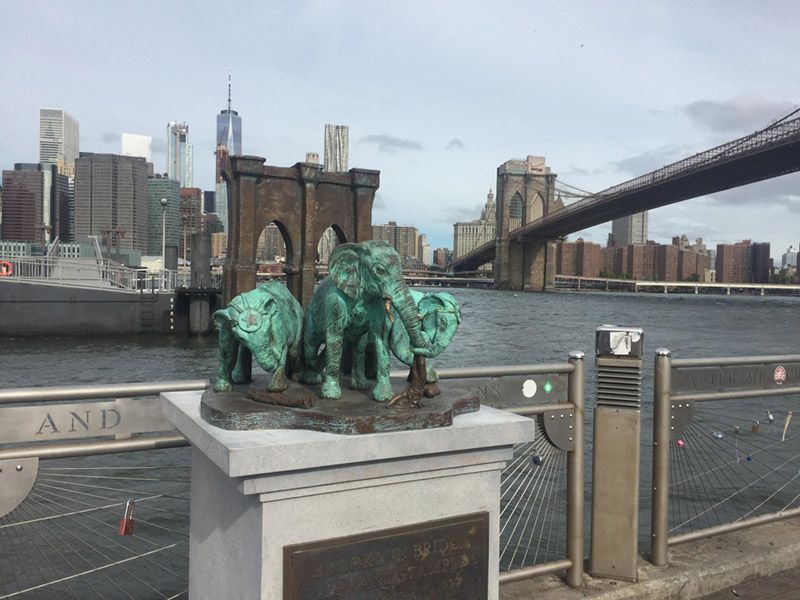
The Brooklyn Bridge is one of New York City’s most iconic and recognizable landmarks, so it makes the perfect dramatic backdrop for impactful outdoor art installations. Drawing on the history of the bridge, the cultures of Brooklyn, and taking advantage of the views at Brooklyn Bridge Park, these art installations have made a lasting impression. From a monument to a made-up historical event to a warship with a fancy paint job, here are 10 unique art installations that appeared at the Brooklyn Bridge:
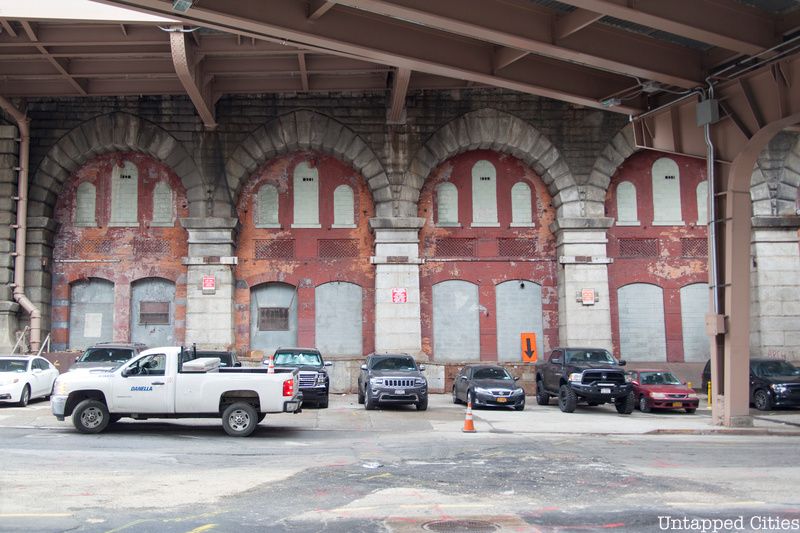
Creative Time has commissioned and presented ambitious public art projects in unique locations all over the world and even outer space! One of the most intriguing locations Creative Time made use of in New York City was the Anchorage inside the foundation of the Brooklyn Bridge. The series of installations, Art in the Anchorage, began in 1983 to celebrate the centennial anniversary of the bridge and continued until 2001.
Over the span of eighteen years, many artists took their work into the cavernous space that bridge designer John A. Roebling had envisioned as a shopping arcade, where masonry piers housed the bridge’s cables. According to Julie Golia, a historian of the Brooklyn Historical Society, Roebling “gave the inside [of each] the same Gothic design as the towers, with beautiful 50-foot-high cathedral ceilings. But that plan fell through, and for most of history, they’ve been municipal storage.” Unfortunately, in 2001 the space was closed off for security reasons.

The newest sculpture to grace the area near the Brooklyn Bridge is In every language there is Land / En cada lengua hay una Tierra by Nicholas Galanin. The monumental sculpture, Galanin’s first piece of public art in New York City, blends his Indigenous heritage with Pop Art aesthetics. Made of corten steel, the same type used for the U.S.-Mexico border wall, the piece stands 30 feet tall.
The steel bars spell out the word “Land” in the style of Robert Indiana’s 1966 sculpture, LOVE. The sculpture debuted in May 2023 in Brooklyn Bridge Park and will be on view through November 12, 2023.
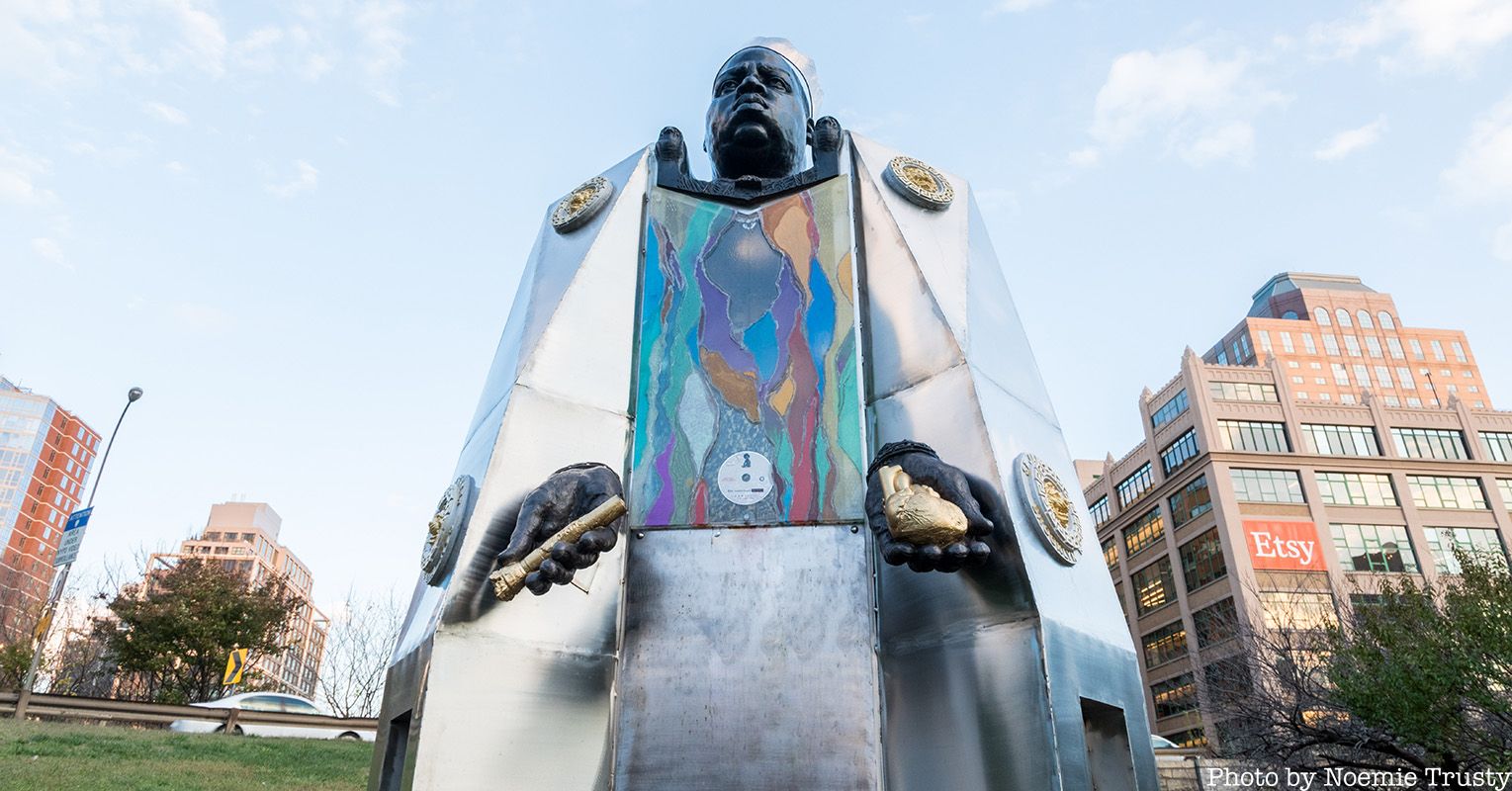
On the northeast corner of Prospect Street and Washington Street, a sculpture of rapper Biggie Smalls stands watching over the Brooklyn Bridge. Made of stainless steel, bronze, and other materials, the artwork includes pieces that tell the story of B.I.G.’s short but impactful musical career. An audio system, which pays homage to the boomboxes of hip hop’s early days, plays a selection of Notorious B.I.G hits.
This 9-foot version of the “King of New York” can be found at the foot of the bridge in DUMBO. It was created by artist Sherwin Banfield and is titled “Sky’s the Limit in the County of Kings.”

In December 2015 Brooklyn based artist Deborah Kass turned the vernacular of Brooklynites into art with her cross-cultural OY/YO sculpture in Brooklyn Bridge Park. The design of the sculpture, which can be read two ways depending on which side you are standing on, originally appeared in 2011 in the form of paintings, small sculptures, and prints. Years later it would become the artist’s first monumental sculpture, taking the form of a massive eight by seventeen foot, bright yellow, aluminum sculpture commissioned by Two Trees Management Company. The piece remained near the bridge until September 2016 and later appeared on the Williamsburg waterfront. You can see the OY/YO sculpture on display now at the Brooklyn Museum as part of the Something to Say exhibit. It will be on view outside until June 30th, 2019 along with work from other artists like Brooklyn Hi-Art! Machine, Kameelah Janan Rasheed and Hank Willis Thomas.

Staten Island Sculptor Joe Reginella took the history of the Brooklyn Bridge and let his imagination run with it to create a fun piece of art that left visitors scratching their heads. In 2017 Reginella created the Brooklyn Bridge Elephant Stampede monument, fusing the real life stories of a stampede on the Brooklyn Bridge and an elephant parade into one fatal fictional tale. The nearly six feet tall bronze sculpture of three elephants trampling human victims stood in Brooklyn Bridge Park with a plaque denoting the tragic story of Jumbo, the star elephant of P.T. Barnum’s circus who, while parading across the Brooklyn Bridge, got spooked and started a stampede that left two elephants dead and many people crushed and injured. The story, which takes place on the day of the stock market crash, fuses the true event of a fatal stampede of people that occurred during the Brooklyn Bridge’s opening week due to an incorrect assumption that the bridge was collapsing, and a parade of twenty-one elephants from P.T. Barnum’s circus that were walked across the bridge to prove its stability.
This year, Reginella ripped from the headlines of another infamous time in New York City’s history – 1976, the “Summer of Sam” and the New York City blackout – to create a new sculpture displayed in The Battery and dedicated to the mysteriously missing sailors of a tugboat that was likely abducted from New York Harbor by a UFO. Reginella’s previous work, in addition to the Elephant Stampede monument, includes a monument to an octopus attack on a ferry in Staten Island harbor.
After debuting a similarly stunning plexi-glass and steel water tower at 20 Jay Street in DUMBO in 2012, artist Tom Fruin created a sculpture to adorn the roof of 334 Furman Street in Brooklyn Bridge Park in 2014. Watertower 3: RV Ingersoll, like all of Fruin’s water tower sculptures, is composed of recycled materials, just about one thousand pieces, personally gathered by the artist. The sculpture can be viewed from numerous vantage points throughout the park, from the Brooklyn Queens Expressway, the Brooklyn Heights Promenade and New York Harbor. The translucent and colorful sculpture catches direct sunlight during the day and is illuminated at night by a solar powered system.

Over the summer Austrian artist Erwin Wurm brought the Hot Dog Bus to Brooklyn Bridge Park and gave out free frankfurters every weekend. Wurm transformed a vintage Volkswagen Microbus into a yellow “overstuffed food truck” that drove around Piers 1 and 5 serving up a summer treat with a message. The hot dog has deep ties to New York and Wurm’s Austrian homeland. The hot dog was a symbol of the Eastern European immigration wave during the 19th century, and is now an iconic food item eaten at American sporting events, barbecues and, of course, on the streets. Wurm took the opportunity to encourage people to think about our habits of overconsumption, because while the bulbous van is cute and whimsical, it points towards a tendency for excess. This project was curated by Public Art Fund’s Associate Curator, Daniel S. Palmer.

The GlassBarge, a floating glass blowing studio from The Corning Museum of Glass, opened at ONE°15 Brooklyn Marina at Brooklyn Bridge Park this past summer. For ten days on the first leg of its state wide journey along the historic waterways of New York, artist onboard gave glass blowing demonstrations using the facility’s patented, boat-tested, all-electric glassmaking equipment. The goal of the GlassBarge was to support and emphasize the important role New York’s waterways have had in shaping “the state’s industry, culture and community,” to bring attention to The Corning Museum (which is located upstate in Steuben County), and to celebrate the 200th anniversary of the construction of the Erie Canal and the centennial of the commemoration of the Barge Canal in New York State. When the Erie canal was completed in 1825, it opened up an important new route for trade and commerce. The Hudson River became an even more vital piece of New York’s economic development.
After its stint in Brooklyn the barge hit six port cities and towns along the Hudson River Valley before venturing further north to the Finger Lakes region where its journey ended on September 22nd.

Photoville is a sprawling, annual pop-up photography exhibit at Brooklyn Bridge Park that is free and open to the public. The exhibit is made up of repurposed shipping containers transformed outdoor photography galleries. The 2018 “village” exhibited work by over 500 artist. The exhibitions are supplemented by talks, workshops, and evening programs for the public to further engage with the art. To help ensure the return of Photoville to Brooklyn Bridge Park next summer, you can make a donation here.
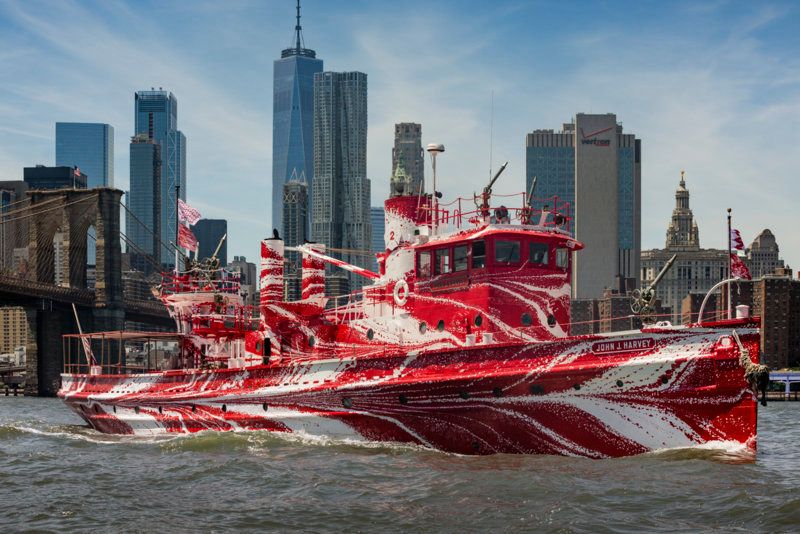
During the summer of 2018 a “dazzle ship” made its home at Pier 6 in Brooklyn Bridge park. “Dazzle ships” date back to World War I when British painter Norman Wilkinson came up with the idea to paint war ships in a way that created an optical illusion, distorting the form of the boat and confusing the enemy. The Fireboat John J. Harvey got a “dazzle ship” makeover by New York artist Tauba Auerbach to commemorate the centennial anniversary of World War I. Over the summer guests were able to climb aboard the ship which was one of four that were commissioned for the occasion. This piece, co-commissioned by the Public Art Fund, is on view now at
Hudson River Park’s Pier 66a.

As part of a year-long celebration of the Public Art Fund’s 40th Anniversary, Descension was unveiled in the spring on 2017 at Pier 1’s Bridge View Lawn. The piece was created by London-based artist Anish Kapoor and featured a whirlpool of water that mesmerizingly swirled into the center. The twenty-six foot whirlpool had previously appeared in other countries around the globe, but this was its first appearance in North America. Kapoor’s former work includes the Sky Mirror at Rockefeller Center and Cloud Gate in Chicago’s Millennium Park.
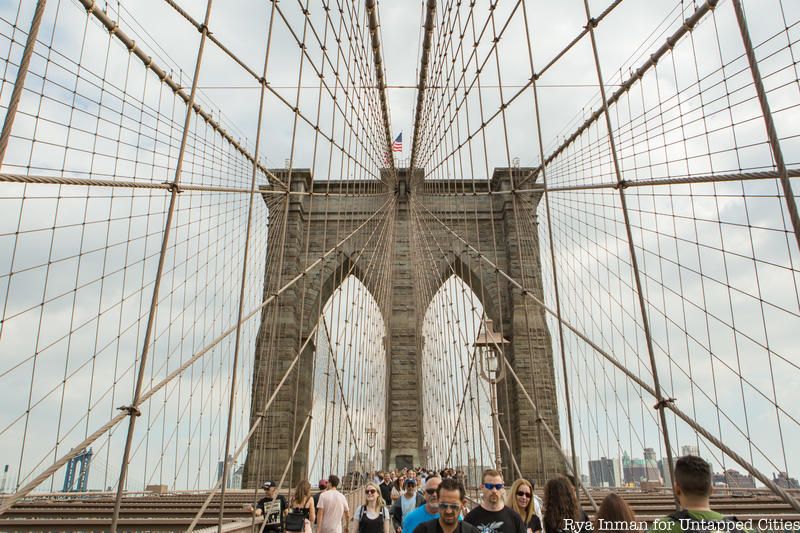
This artistic stunt caused quite a frenzy when it happened back in the summer of 2014. The large american flags that adorn the top of the Brooklyn Bridge were replaced by solid white flags and no one knew how or why they were changed. Since the perpetrators would have had to climb to the top of the bridge to make the switch, and they were able to do so without being caught by covering the lights shining on the flagpoles, some New Yorkers were concerned for pubic safety. Eventually, a pair of artists from Berlin, Mischa Leinkauf and Matthias Wermke, fessed up to being responsible for the switch. They told the New York Times that the purpose of the installation of the two all white flags, which each had white hand-stitched stars and stripes, was to celebrate “the beauty of public space.” The artist also pulled the stunt to honor the bridge’s German-born engineer, John Roebling, who died in 1869 on July 22, the day the white flags appeared.

Lox is a big deal in Brooklyn. Earlier this year a Acme Smoked Fish and Zucker’s Bagels set the world record for the largest salmon lox bagel. Less of an art installation and more of a PSA, in a bid to stop people from putting “love locks” on the Brooklyn Bridge, the NYC DOT called on the Jewish heritage prevalent in Brooklyn and the boroughs love of lox by incorporating it into a “punny” sign that read, “NO LOCKS, YES LOX.” Putting love locks on a bridge is a tradition that started across the Atlantic in either Rome or Paris, where the Pont des Arts and other bridges are similarly embattled. The locks are a sign of eternal love for couples but eternal headaches for the city. The NYC Department of Transportation is regularly dispatching teams to remove the locks from the Brooklyn Bridge, removing over 34,000 since 2013 at a cost of $100,000. The weight of the love locks even caused a wire to snap on September 8th back in 2016, leading to extensive delays and repairs.
Next, check out 57 NYC Outdoor (and Indoor) Art Installations Not to Miss in November 2018
Subscribe to our newsletter